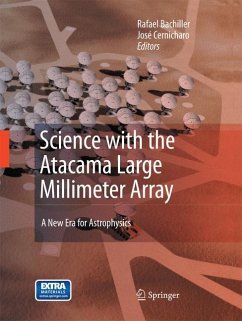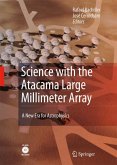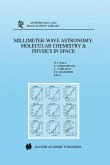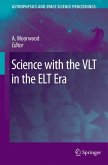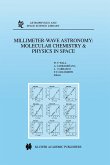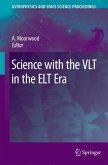Science with the Atacama Large Millimeter Array:
A New Era for Astrophysics
Herausgegeben:Bachiller, Rafael; Cernicharo Quintanilla, José
Science with the Atacama Large Millimeter Array:
A New Era for Astrophysics
Herausgegeben:Bachiller, Rafael; Cernicharo Quintanilla, José
- Broschiertes Buch
- Merkliste
- Auf die Merkliste
- Bewerten Bewerten
- Teilen
- Produkt teilen
- Produkterinnerung
- Produkterinnerung
Currently under construction in the Andean Altiplano, Northern Chile, the Atacama Large Millimeter Array (ALMA) is the most ambitious astronomy facility under construction. ALMA is a radio interferometer composed of 54 antennas of 12 m diameter, and twelve 7 m antennas with about 6600 square meters of total collecting area. Initially covering the most interesting spectral wavelength ranges from 3 to 0.3 mm, ALMA will be a revolutionary telescope aimed to unveil the details of star and planet formation and to provide astronomy with the first exhaustive view of the dark and youngest objects of…mehr
![Science with the Atacama Large Millimeter Array: Science with the Atacama Large Millimeter Array:]() Rafael Bachiller / José Cernicharo (eds.)Science with the Atacama Large Millimeter Array:148,99 €
Rafael Bachiller / José Cernicharo (eds.)Science with the Atacama Large Millimeter Array:148,99 €![Millimeter-Wave Astronomy: Molecular Chemistry & Physics in Space Millimeter-Wave Astronomy: Molecular Chemistry & Physics in Space]() Millimeter-Wave Astronomy: Molecular Chemistry & Physics in Space147,99 €
Millimeter-Wave Astronomy: Molecular Chemistry & Physics in Space147,99 €![Formation and Evolution of Galaxies and Large Structures in the Universe Formation and Evolution of Galaxies and Large Structures in the Universe]() J. Audouze (ed.) / J.T.T. VanFormation and Evolution of Galaxies and Large Structures in the Universe113,99 €
J. Audouze (ed.) / J.T.T. VanFormation and Evolution of Galaxies and Large Structures in the Universe113,99 €![Science with the VLT in the ELT Era Science with the VLT in the ELT Era]() Science with the VLT in the ELT Era147,99 €
Science with the VLT in the ELT Era147,99 €![Formation and Evolution of Galaxies and Large Structures in the Universe Formation and Evolution of Galaxies and Large Structures in the Universe]() Formation and Evolution of Galaxies and Large Structures in the Universe42,99 €
Formation and Evolution of Galaxies and Large Structures in the Universe42,99 €![Millimeter-Wave Astronomy: Molecular Chemistry & Physics in Space Millimeter-Wave Astronomy: Molecular Chemistry & Physics in Space]() W.F. Wall / Alberto Carramiñana / Luis Carrasco / P.F. Goldsmith (eds.)Millimeter-Wave Astronomy: Molecular Chemistry & Physics in Space166,99 €
W.F. Wall / Alberto Carramiñana / Luis Carrasco / P.F. Goldsmith (eds.)Millimeter-Wave Astronomy: Molecular Chemistry & Physics in Space166,99 €![Science with the VLT in the ELT Era Science with the VLT in the ELT Era]() Science with the VLT in the ELT Era147,99 €
Science with the VLT in the ELT Era147,99 €-
-
-
This book describes the enormous capabilities of ALMA, the state of the project, and most notably the scientific prospects with such a unique facility. The book includes comprehensive reviews and recent results on most hot topics of modern Astronomy (the formation and evolution of galaxies, the physics and chemistry of the interstellar medium, and the processes of star and planet formation) with prospects to the revolutionary results to be obtained with ALMA. These topics, discussed with special emphasis on millimeter and sub-millimeter astronomy, are presented by some of the most world-wide reputed scientists in their fields.
- Produktdetails
- Verlag: Springer / Springer Netherlands
- Artikelnr. des Verlages: 978-94-017-8484-9
- 2008
- Seitenzahl: 368
- Erscheinungstermin: 17. November 2014
- Englisch
- Abmessung: 279mm x 210mm x 20mm
- Gewicht: 906g
- ISBN-13: 9789401784849
- ISBN-10: 9401784841
- Artikelnr.: 41902778
- Herstellerkennzeichnung
- Books on Demand GmbH
- In de Tarpen 42
- 22848 Norderstedt
- info@bod.de
- 040 53433511
- Verlag: Springer / Springer Netherlands
- Artikelnr. des Verlages: 978-94-017-8484-9
- 2008
- Seitenzahl: 368
- Erscheinungstermin: 17. November 2014
- Englisch
- Abmessung: 279mm x 210mm x 20mm
- Gewicht: 906g
- ISBN-13: 9789401784849
- ISBN-10: 9401784841
- Artikelnr.: 41902778
- Herstellerkennzeichnung
- Books on Demand GmbH
- In de Tarpen 42
- 22848 Norderstedt
- info@bod.de
- 040 53433511

